Fishwick P.A. (editor) Handbook of Dynamic System Modeling
Подождите немного. Документ загружается.

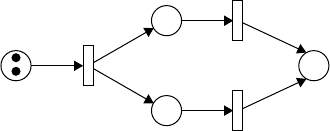
24-2 Handbook of Dynamic System Modeling
an output place. This elementary net may be used to represent various aspects of the modeled systems. For
example, a transition and its input place and output place can be used to represent a data processing event,
its input data and output data, respectively, in a data processing system. To study the dynamic behavior of
a Petri net modeled system in terms of its states and state changes, each place may contain zero or a positive
number of tokens. Tokens are a primitive concept for Petri nets in addition to places and transitions. The
presence or absence of a token in a place can indicate whether a condition associated with this place is true
or false, for instance.
Denote by N the set of nonnegative integers. A Petri net is formally defined as a five-tuple N =(P, T, I,
O, M
0
), where
(1) P ={p
1
, p
2
,…,p
m
} is a finite set of places.
(2) T ={t
1
, t
2
,…,t
n
} is a finite set of transitions. P ∪T =and P ∩T =.
(3) I: T ×P →N is an input matrix that specifies directed arcs from places to transitions; its entry I(t
i
,
p
j
) represents the number of arcs connecting place p
j
to transition t
i
.
(4) O: T ×P →N is an output matrix that specifies directed arcs from transitions to places; its entry
O(t
i
, p
j
) represents the number of arcs connecting transition t
i
to place p
j
.
(5) M
0
: P →N is the initial marking.
A marking in a Petri net is an assignment of tokens to the places of a Petri net. Tokens reside in the
places of a Petri net. The number and position of tokens may change during the execution of a Petri net.
The tokens are used to define the execution of a Petri net.
Most theoretical work on Petri nets is based on the formal definition of Petri nets. However, a graphical
representation of a Petri net is much more useful for illustrating the concepts of Petri net theory. A Petri
net graph is a Petri net depicted as a bipartite directed multigraph. Corresponding to the definition of
Petri nets, a Petri net graph has two types of nodes: a circle that represents a place, and a bar or box that
represents a transition. Directed arcs (arrows) connect places and transitions, with some arcs directed from
places to transitions and other arcs directed from transitions to places. An arc directed from a place p
j
to a
transition t
i
defines p
j
to be an input place of t
i
, denoted by I(t
i
, p
j
) =1. An arc directed from a transition t
i
to a place p
j
defines p
j
to be an output place of t
i
, denoted by O(t
i
, p
j
) =1. If I(t
i
, p
j
) =k (or O(t
i
, p
j
) =k),
then there exist k directed (parallel) arcs connecting place p
j
to transition t
i
(or connecting transition t
i
to place p
j
). Usually, in the graphical representation, parallel arcs connecting a place (transition) to a
transition (place) are represented by a single directed arc labeled with its multiplicity, or weight k. A circle
containing a dot represents a place contains a token (Peterson, 1981).
Example 1
A simple Petri net.
Figure 24.1 shows a simple Petri net. In this Petri net, we have
P ={p
1
, p
2
, p
3
, p
4
};
T ={t
1
, t
2
, t
3
};
I(t
1
, p
1
) =2, I(t
1
, p
i
) =0 for i =2, 3, 4;
p
2
p
3
t
3
t
2
2
2
t
1
p
1
p
4
FIGURE 24.1 A simple Petri net.

Petri Nets for Dynamic Event-Driven System Modeling 24-3
I(t
2
, p
2
) =1, I(t
2
, p
i
) =0 for i =1, 3, 4;
I(t
3
, p
3
) =1, I(t
3
, p
i
) =0 for i =1, 2, 4;
O(t
1
, p
2
) =2, O(t
1
, p
3
) =1, O(t
1
, p
i
) =0 for i =1, 4;
O(t
2
, p
4
) =1, O(t
2
, p
i
) =0 for i =1, 2, 3;
O(t
3
, p
4
) =1, O(t
3
, p
i
) =0 for i =1, 2, 3;
M
0
=(2 0 0 0).
24.3 Transition Firing
The execution of a Petri net is controlled by the number and distribution of tokens in the Petri net.
By changing distribution of tokens in places, which may reflect the occurrence of events or execution of
operations, for instance, one can study the dynamic behavior of the modeled system. A Petri net is executed
by firing transitions. We now introduce the enabling rule and firing rule of a transition, which govern the
flows of tokens:
(1) Enabling Rule: A transition t is said to be enabled if each input place p of t contains at least the
number of tokens equal to the weight of the directed arc connecting p to t, i.e., M(p) ≥I(t, p) for
all p in P.IfI(t, p) =0, then t and p are not connected, so we do not care about the marking of p
when considering the firing of t.
(2) Firing Rule: Only enabled transitions can fire. The firing of an enabled transition t removes from
each input place p the number of tokens equal to I(t, p), and deposits in each output place p the
number of tokens equal to O(t, p).
Mathematically, firing t at M yields a new marking
M
(p) = M(p) − I(t, p) +O(t, p) for all p in P
Note that since only enabled transitions can fire, the number of tokens in each place always remains
nonnegative when a transition is fired. Firing a transition can never try to remove a token that is not there.
A transition without any input place is called a source transition, and one without any output place is
called a sink transition. Note that a source transition is unconditionally enabled, and that the firing of a
sink transition consumes tokens, but does not produce tokens.
A pair of a place p and a transition t is called a self-loop,ifp is both an input place and an output place
of t. A Petri net is said to be pure if it has no self-loops.
Example 2
Transition firing.
Consider the simple Petri net shown in Figure 24.1. Under the initial marking, M
0
=(2000),onlyt
1
is
enabled. Firing of t
1
results in a new marking, say M
1
. It follows from the firing rule that
M
1
= (0210)
The new token distribution of this Petri net is shown in Figure 24.2. Again, in marking M
1
, both
transitions of t
2
and t
3
are enabled. If t
2
fires, the new marking, say M
2
,is
M
2
= (0111)
If t
3
fires, the new marking, say M
3
,is
M
3
= (0201)
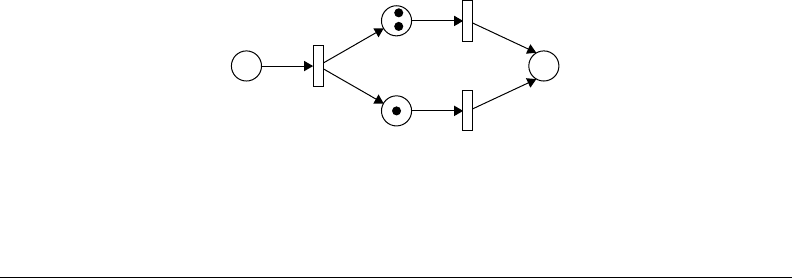
24-4 Handbook of Dynamic System Modeling
p
2
p
3
t
3
t
2
2
2
t
1
p
1
p
4
FIGURE 24.2 Firing of transition t
1
.
24.4 Modeling Power
The typical characteristics exhibitedbythe activities in a dynamic event-drivensystem,such as concurrency,
decision making, synchronization, and priorities, can be modeled effectively by Petri nets.
1. Sequential Execution. In Figure 24.3(a), transition t
2
can fire only after the firing of t
1
. This imposes
the precedence constraint “t
2
after t
1
.” Such precedence constraints are typical of the execution of
the parts in a dynamic system. Also, this Petri net construct models the causal relationship among
activities.
2. Conflict. Transitions t
1
and t
2
are in conflict in Figure 24.3(b). Both are enabled but the firing of
any transition leads to the disabling of the other transition. Such a situation will arise, for example,
when a machine has to choose among part types or a part has to choose among several machines.
The resulting conflict may be resolved in a purely nondeterministic way or in a probabilistic way,
by assigning appropriate probabilities to the conflicting transitions.
3. Concurrency. In Figure 24.3(c), the transitions t
1
and t
2
are concurrent. Concurrency is an important
attribute of system interactions.
4. Synchronization. It is quite normal in a dynamic system that an event requires multiple resources.
The resulting synchronization of resources can be captured by transitions of the type shown in
Figure 24.3(d). Here, t
1
is enabled only when each of p
1
and p
2
receives a token. The arrival of a
token into each of the two places could be the result of a possibly complex sequence of operations
elsewhere in the rest of the Petri net model. Essentially, transition t
1
models the joining operation.
5. Mutually exclusive. Two processes are mutually exclusive if they cannot be performed at the same
time due to constraints on the usage of shared resources. Figure 24.3(e) shows this structure. For
example, a robot may be shared by two machines for loading and unloading. Two such structures
are parallel mutual exclusion and sequential mutual exclusion.
6. Priorities. The classical Petri nets discussed so far have no mechanism to represent priorities. Such
a modeling power can be achieved by introducing an inhibitor arc. The inhibitor arc connects an
input place to a transition, and is pictorially represented by an arc terminated with a small circle.
The presence of an inhibitor arc connecting an input place to a transition changes the transition-
enabling conditions. In the presence of the inhibitor arc, a transition is regarded as enabled if each
input place, connected to the transition by a normal arc (an arc terminated with an arrow), contains
at least the number of tokens equal to the weight of the arc, and no tokens are present on each
input place connected to the transition by the inhibitor arc. The transition firing rule is the same
for normally connected places. The firing, however, does not change the marking in the inhibitor
arc connected places. A Petri net with an inhibitor arc is shown in Figure 24.3(f). t
1
is enabled if p
1
contains a token, while t
2
is enabled if p
2
contains a token and p
1
has no token. This gives priority to
t
1
over t
2
: in a marking in which both p
1
and p
2
have a token,t
2
would not be able to fire until t
1
is fired.
7. Resource constraint. Petri nets are well suited to model and analyze systems that are constrained by
resources. For instance, Figure 24.4 depicts the Petri net model of a queue with two servers. The
transition a models the arrival of clients, b and c indicate the start and end of the service, whereas
d models the departure. The place p indicates clients that are waiting to be served, q models clients
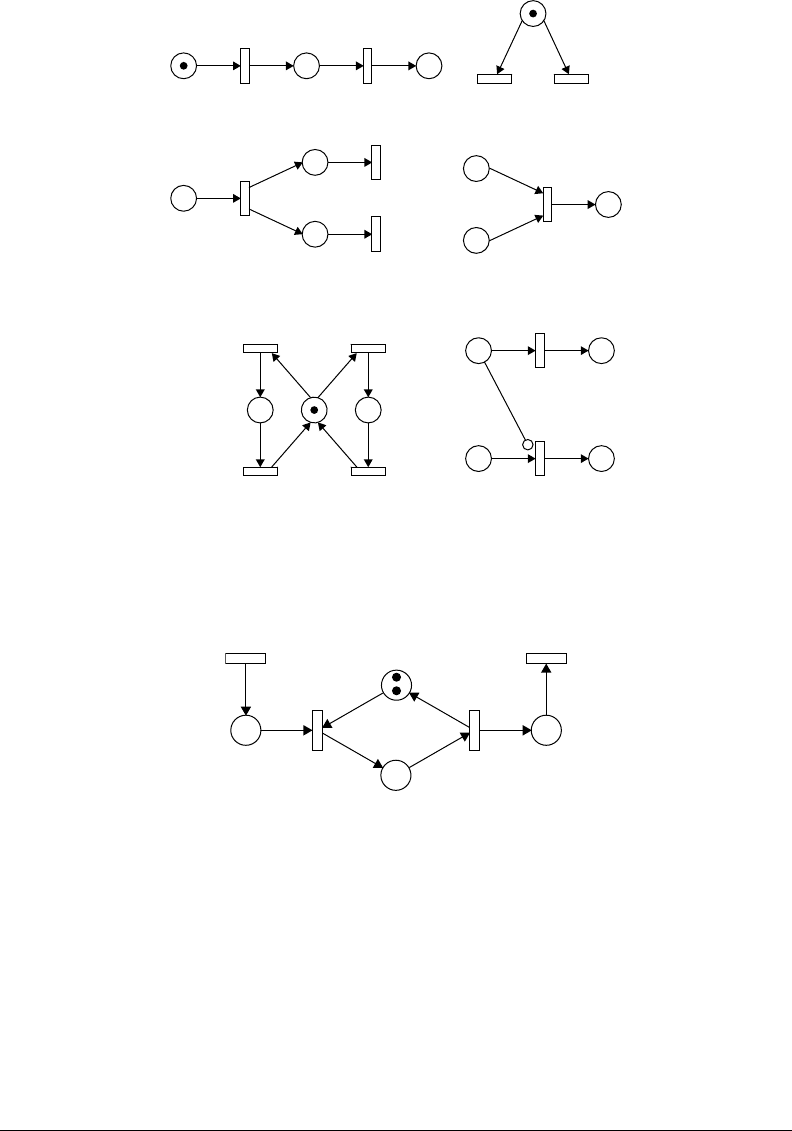
Petri Nets for Dynamic Event-Driven System Modeling 24-5
p
1
t
1
t
2
t
1
p
2
p
1
t
1
t
2
p
1
p
2
(a)
(c)
(e)
(b)
(d)
(f)
t
1
t
2
p
1
p
3
t
1
t
2
p
2
p
3
t
3
t
4
p
1
t
1
p
2
p
1
t
2
FIGURE 24.3 Petri net primitives to represent system features. (a) Sequential, (b) conflict, (c) concurrent,
(d) synchronization, (e) mutual exclusive, and (f) priority.
r
q
p
s
c
a
b
d
FIGURE 24.4 A queue with two servers.
that are being served. A client being served occupies a resource, the server. Place s indicates free
resources; initially there are two resources (servers) available. To fire b, a waiting client in place p
andafreeserverinplaces have to be available. When the first client arrives, a server becomes busy.
When the second client arrives before the first one has finished, the second server becomes busy as
well. When the third arrives before the other two have finished, he has to wait until one of the two
servers becomes available. The modeling of situations like the one sketched, where behaviors are
concurrent up to a certain degree, can be done very naturally by means of Petri nets.
24.5 Petri Net Properties
As a mathematical tool, Petri nets possess a number of properties. These properties, when interpreted
in the context of the modeled system, allow system designer to identify the presence or absence of the
application domain-specific functional properties of the system under design. Two types of properties
24-6 Handbook of Dynamic System Modeling
can be distinguished, behavioral and structural. The behavioral properties are those which depend on the
initial state or marking of a Petri net. In contrast, the structural properties do not depend on the initial
marking of a Petri net. They depend on the topology, or net structure, of a Petri net (Murata, 1989).
Here we provide an overview of some of the most important, from the practical point of view, behavioral
properties: reachability, safeness, and liveness.
24.5.1 Reachability
An important issue in designing event-driven systems is whether a system can reach a specific state, or
exhibit a particular functional behavior. In general, the question is whether the system modeled with a Petri
net exhibits all desirable properties as specified in the requirement specification, and no undesirable ones.
To find out whether the modeled system can reach a specific state as a result of a required functional
behavior, it is necessary to find such a transition firing sequence that would transform its Petri net model
from the initial marking M
0
to the desired marking M
j
,whereM
j
represents the specific state, and the
firing sequence represents the required functional behavior. In general, a marking M
j
is said to be reachable
from a marking M
i
if there exists a sequence of transition firings that transforms M
i
to M
j
. A marking M
j
is said to be immediately reachable from M
i
if firing an enabled transition in M
i
results in M
j
. The set of
all markings reachable from marking M is denoted by R(M). We will explain how to get R(M) later.
24.5.2 Safeness
In a Petri net, places are often used to represent information storage areas in communication and computer
systems, product and tool storage areas in manufacturing systems, etc. It is important to be able to
determine whether proposed control strategies prevent from the overflows of these storage areas. The Petri
net property, which helps to identify the existence of overflows in the modeled system, is the concept of
boundedness.
A place p is said to be k-bounded if the number of tokens in p is always less than or equal to k (k is a
nonnegative integer number) for every marking M reachable from the initial marking M
0
, i.e., M ∈R(M
0
).
It is safe if it is 1-bounded.
A Petri net N =(P, T, I, O, M
0
)isk-bounded (safe) if each place in P is k-bounded (safe). It is
unbounded if k is infinitely large. For example, the Petri net of Figure 24.1 is 2-bounded, but the net of
Figure 24.4 is unbounded.
24.5.3 Liveness
The concept of liveness is closely related to the deadlock situation, which has been situated extensively in
the context of computer operating systems.
A Petri net modeling a deadlock-free system must be live. This implies that for any reachable marking
M, any transition in the net can eventually be fired by progressing through some firing sequence. This
requirement,however, might be too strict to represent some real systems or scenarios that exhibit deadlock-
free behavior. For instance, the initialization of a system can be modeled by a transition (or a set of
transitions) that fires a finite number of times. After initialization, the system may exhibit a deadlock-free
behavior, although the Petri net representing this system is no longer live as specified above. For this
reason, different levels of liveness are defined. Denote by L(M
0
) the set of all possible firing sequences
starting from M
0
. A transition t in a Petri net is said to be
(1) L0-live (or dead) if there is no firing sequence in L(M
0
)inwhicht can fire.
(2) L1-live (potentially firable) if t can be fired at least once in some firing sequence in L(M
0
).
(3) L2-live if t can be fired at least k times in some firing sequence in L(M
0
) given any positive integer k.
(4) L3-live if t can be fired infinitely often in some firing sequence in L(M
0
).
(5) L4-live (or live) if t is L1-live (potentially firable) in every marking in R(M
0
).

Petri Nets for Dynamic Event-Driven System Modeling 24-7
For example, all the three transitions in the net of Figure 24.1 are L1-live because t
1
and t
3
can only fire
once each while transition t
2
can fire twice. However, all transitions in the net of Figure 24.4 are L4-live,
because they are all L1-live in every reachable marking.
24.6 Analysis of Petri Nets
We have introduced the modeling power of Petri nets in the previous sections. However, modeling by itself
is of little use. It is necessary to analyze the modeled system. This analysis will hopefully lead to important
insights into the behavior of the modeled system.
There are four common approaches to Petri net analysis: (1) reachability analysis, (2) the matrix-
equation approach, (3) invariant analysis, and (4) simulation. The first approach involves the enumeration
of all reachable markings, but it suffers from the state-space explosion issue. The matrix-equations tech-
nique is powerful but in many cases it is applicable only to special subclasses of Petri nets or special
situations. The invariant analysis determines sets of places or transitions with special features, as token
conservation or cyclical behavior. For complex Petri net models, discrete-event simulation is an option to
check the system properties.
24.6.1 Reachability Analysis
Reachability analysis is conducted through the construction of reachability tree if the net is bounded. Given
a Petri net N, from its initial marking M
0
, we can obtain as many “new” markings as the number of the
enabled transitions. From each new marking, we can again reach more markings. Repeating the procedure
over and over results in a tree representation of the markings. Nodes represent markings generated from
M
0
and its successors, and each arc represents a transition firing, which transforms one marking to another.
The above tree representation, however, will grow infinitely large if the net is unbounded. To keep the
tree finite, we introduce a special symbol ω, which can be thought of as “infinity.” It has the properties
that for each integer n, ω>n, ω +n =ω, and ω ≥ω. Generally, we do not know if a Petri net is bounded
or not before we perform the reachability analysis. However, we can construct a coverability tree if the net
is unbounded or a reachability tree if the net is bounded according to the following general algorithm:
1. Label the initial marking M
0
as the root and tag it “new.”
2. For every new marking M:
2.1. If M is identical to a marking already appeared in the tree, then tag M “old” and go to another
new marking.
2.2. If no transitions are enabled at M, tag M “dead-end” and go to another new marking.
2.3. While there exist enabled transitions at M, do the following for each enabled transition t at M:
2.3.1. Obtain the marking M
that results from firing t at M.
2.3.2. On the path from the root to M if there exists a marking M
such that M
(p) ≥M
(p) for
each place p and M
=M
, i.e., M
is coverable, then replace M
(p) by ω for each p such
that M
(p) > M
(p).
2.3.3. Introduce M
as a node, draw an arc with label t from M to M
, and tag M
“new.”
If ω appears in a marking, then the net is unbounded and the tree is a coverability tree; otherwise, the net
is bounded and the tree is a reachability tree. Merging the same nodes in a coverability tree (reachability
tree) results in a coverability graph (reachability graph).
Example 3
Reachability analysis.
Consider the Petri net shown in Figure 24.1. All reachable markings are M
0
=(2, 0, 0, 0), M
1
=(0, 2,
1, 0), M
2
=(0, 1, 1, 1), M
3
=(0, 2, 0, 1), M
4
=(0, 0, 1, 2), M
5
=(0, 1, 0, 2), and M
6
=(0, 0, 0, 3).
The reachability tree of this Petri net is shown in Figure 24.5(a), and the reachability graph is shown in
Figure 24.5(b).
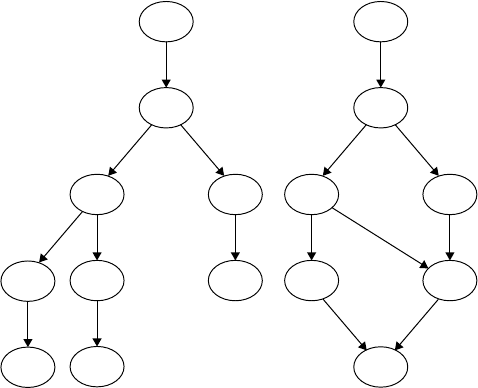
24-8 Handbook of Dynamic System Modeling
M
2
M
3
M
5
M
4
M
6
t
2
t
3
t
2
t
2
t
3
M
0
M
1
t
1
M
4
Old
Root
Old
t
3
t
2
M
6
t
2
Dead-end
(a) (b)
M
3
M
2
M
3
M
4
t
2
t
3
t
3
t
2
t
2
t
2
M
0
M
1
t
1
t
3
M
5
FIGURE 24.5 (a) Reachability tree. (b) Reachability graph.
24.6.2 Incidence Matrix and State Equation
ForaPetrinetwithn transitions and m places, the incidence matrix A =[a
ij
]isann ×m matrix of integers
and its entry is given by
a
ij
= O(t
i
, p
j
) −I(t
i
, p
j
)
In writing matrix equations, we write a marking M
k
as an m ×1 column vector. The jth entry of M
k
denotes the number of tokens in place j immediately after the kth firing in some firing sequence. The
kth firing or control vector u
k
is an n ×1 column vector of n −1zeroesandonenonzeroentry,a1inthe
ith position indicating that transition i fires at the kth firing. Since the ith row of the incidence matrix A
denotes the change of the marking as the result of firing transition i, we can write the following state
equation for a Petri net:
M
k
= M
k−1
+A
T
u
k
, k = 1, 2, ...
Suppose that a destination marking M
d
is reachable from M
0
through a firing sequence {u
1
, u
2
…, u
d
}.
Writing the state equation for k =1, 2, …, d and summing them, we obtain
M
d
= M
0
+A
T
d
k=1
u
k
This state equation specifies a necessary condition for marking M
d
being reachable from M
0
, which is that
there is a nonnegative solution of the firing vector
d
k=1
u
k
.
24.6.3 Invariant Analysis
In a Petri net, arcs describe the relationships among places and transitions. They are represented by two
matrices I and O. By examining the linear equations based on the execution rule and the matrices, one
can find subsets of places over which the sum of the tokens remains unchanged. One may also find that
a transition firing sequence brings the marking back to the same one. The concepts of S-invariant and
T-invariant are introduced to reflect these properties.
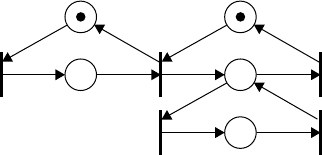
Petri Nets for Dynamic Event-Driven System Modeling 24-9
Mathematically, an S-invariant is an integer solution y of the homogeneous equation
Ay = 0
and a T-invariant is an integer solution x of the homogeneous equation
A
T
x = 0
The nonzero entries in an S-invariant represent weights associated with the corresponding places so that
the weighted sum of tokens on these places is constant for all markings reachable from an initial marking.
These places are said to be covered by an S-invariant. The nonzero entries in a T-invariant represent the
firing counts of the corresponding transitions, which belongs to a firing sequence transforming a marking
M
0
back to M
0
. Although a T-invariant states the transitions comprising the firing sequence transforming
a marking M
0
back to M
0
, and the number of times these transitions appear in this sequence, it does not
specify the order of the transition firings.
Invariant findings may help in the analysis of some Petri net properties. For example, if each place in a
netiscoveredbyanS-invariant, then it is bounded. However, this approach is of limited use since invariant
analysis does not include all the information of a general Petri net.
The set of places (transitions) corresponding to nonzero entries in an S-invariant y ≥0(T-invariant
x ≥0) is called the support of an invariant and is denoted by x (y). A support is said to be minimal
if there is no other invariant y
1
such that y
1
(p) ≤y(p) for all p. Given a minimal support of an invariant,
there is a unique minimal invariant corresponding to the minimal support. We call such an invariant a
minimal-support invariant. The set of all possible minimal-support invariants can serve as a generator of
invariants. That is, any invariant can be written as a linear combination of minimal-support invariants
(Memmi and Roucairol, 1980).
Example 4
Figure 24.6 shows a simple manufacturing system with a single machine and a buffer. The capacity of
the buffer is 1. A raw part can enter the buffer only when it is empty, otherwise it is rejected. As soon
as the part residing in the buffer gets processed, the buffer is released and can accept another coming
part. Fault may occur in the machine when it is processing a part. After being repaired, the machine
continues to process the uncompleted part. The places and transitions in this Petri net are as follows:
p
1
: The buffer available.
p
2
: A part in the buffer.
p
3
: The machine available.
p
4
: The machine processing a part.
p
5
: The machine failed.
t
1
: A part arrives.
t
2
: The machine starts processing a part.
t
3
: The machine ends processing a part.
t
1
t
2
p
1
p
2
t
3
p
3
p
4
t
5
t
4
p
5
FIGURE 24.6 A simple manufacturing system with a single machine and a buffer.

24-10 Handbook of Dynamic System Modeling
t
4
: The machine fails.
t
5
: Repair the machine.
We are going to find the S-invariants of the net and use them to see how this simple manufacturing
system works. First, we obtain the incidence matrix directly from the model:
A =
⎡
⎢
⎢
⎢
⎢
⎣
−11000
1 −1 −11 0
001−10
000−11
0001−1
⎤
⎥
⎥
⎥
⎥
⎦
Then, by solving Ay =0 we get two minimal-support S-invariants, y
1
=(11000)
T
and y
2
=(00111)
T
,
where y
1
={p
1
, p
2
} and y
2
={p
3
, p
4,
p
5
} are corresponding minimal supports. Since the initial
marking is M
0
=(10100)
T
, then M
T
0
y
1
=1 and this leads to the fact that
M(p
1
) +M(p
2
) = 1
It shows that the buffer is either free or busy. Similarly, it results from M
T
0
y
2
=1 that
M(p
3
) +M(p
4
) +M(p
5
) = 1
It shows how the machine spends its time. It is either up and waiting, or up and working, or down.
24.6.4 Simulation
For complex Petri net models, simulation is another way to check the system properties. The idea is simple,
that is, using the execution algorithm to run the net. Simulation is an expensive and time-consuming
technique. It can show the presence of undesirable properties but cannot prove the correctness of the
model in general case. Despite this, Petri net simulation is indeed a convenient and straightforward yet
effective approach for engineers to validate the desired properties of a discrete-event system. The algorithm
is given as follows:
(1) Initialization: decide the initial marking and the set of all enabled transitions in the marking.
(2) If the number of preset simulation steps or certain stopping criteria is met, stop. Otherwise, if there is
no transition enabled, report a deadlock marking and either stop or go to Step 1.
(3) Randomly pick a transition to fire. Remove the same number of tokens from each of its input places as
the number of arcs from that place to the transition and deposit the same number of tokens to each of
its output places as the number of arcs from the transition to that place.
(4) Remove all disabled transitions from the enabled transition set, and add all newly enabled ones to the
enabled transition set. Go to Step 2.
The above algorithm can be modified to simulate extended Petri nets such as timed ones. The
advantage of the simulation methods is to allow one to derive the temporal performance for a system
under very realistic assumptions. A list of Petri net simulation tools along with feature descriptions can
be found in the following Petri Nets World website: http://www.informatik.uni-hamburg.
de/TGI/PetriNets/.
24.7 Colored Petri Nets
In a standard Petri net, tokens are indistinguishable. Because of this, Petri nets have the distinct dis-
advantage of producing very large and unstructured specifications for the systems being modeled. To
tackle this issue, high-level Petri nets were developed to allow compact system representation. Colored
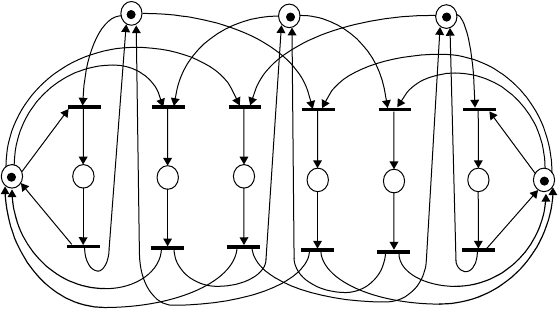
Petri Nets for Dynamic Event-Driven System Modeling 24-11
Petri nets (CPNs) (Jensen, 1981) and Predicate/Transition (Pr/T) nets (Genrich and Lautenbach, 1981)
are among the most popular high-level Petri nets. We will introduce colored Petri nets in this section.
Introduced by Kurt Jensen in 1981, a CPN has its each token attached with a color, indicating the identity
of the token. Moreover, each place and each transition has a set of colors attached. A transition can fire
with respect to each of its colors. By firing a transition, tokens are removed from the input places and added
to the output places in the same way as that in original Petri nets, except that a functional dependency is
specified between the color of the transition firing and the colors of the involved tokens. The color attached
to a token may be changed by a transition firing and it often represents a complex data-value. CPNs lead
to compact net models by using of the concept of colors. This is illustrated by Example 5.
Example 5
A manufacturing system.
Consider a simple manufacturing system comprising two machines M1 and M2, which process three
different types of raw parts. Each type of parts goes through one stage of operation, which can be
performed on either M1 or M2. After the completion of processing of a part, the part is unloaded from
the system and a fresh part of the same type is loaded into the system. Figure 24.7 shows the (uncolored)
Petri net model of the system. The places and transitions in the model are as follows:
p
1
(p
2
): Machine M1 (M2) available.
p
3
(p
4
, p
5
): A raw part of type 1 (type 2, type 3) available.
p
6
(p
7
, p
8
): M1 processing a raw part of type 1 (type 2, type 3).
p
9
(p
10
, p
11
): M2 processing a raw part of type 1 (type 2, type 3).
t
1
(t
2
, t
3
): M1 begins processing a raw part of type 1 (type 2, type 3).
t
4
(t
5
, t
6
): M2 begins processing a raw part of type 1 (type 2, type 3).
t
7
(t
8
, t
9
): M1 ends processing a raw part of type 1 (type 2, type 3).
t
10
(t
11
, t
12
): M2 ends processing a raw part of type 1 (type 2, type 3).
Now let us take a look at the CPN model of this manufacturing system, which is shown in Figure
24.8. As we can see, there are only 3 places and 2 transitions in the CPN model, compared at 11 places
and 12 transitions in Figure 24.7. In this CPN model, p
1
means machines are available (corresponding
to places p
1
and p
2
in Figure 24.7), p
2
means parts available (corresponding to places p
3
−p
5
in Fig-
ure 24.7), p
3
means processing in progress (corresponding to places p
6
−p
11
in Figure 24.7), t
1
means
processing starts (corresponding to transitions t
1
−t
6
in Figure 24.7), and t
2
means processing ends
t
1
t
7
p
6
t
2
t
8
p
7
t
3
t
9
p
8
t
4
t
10
p
9
t
5
t
11
p
10
t
6
t
12
p
11
p
3
p
4
p
5
p
1
p
2
FIGURE 24.7 Petri net model of a simple manufacturing system.
